
views
Repairing Damaged Spots
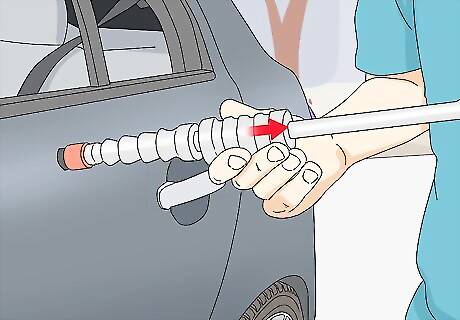
Pull out large dents using a dent repair kit. If the car you’re painting is heavily dented, the first thing you’ll need to do is to remove as many dents as you can to smooth out your painting surface. Glue an appropriately-sized suction cup to the center of the dent using a hot glue gun and wait 1-2 minutes for the glue to harden. Then, pull firmly yet gently on the retractable tab until the metal returns to its original shape. You can pick up a dent repair kit from any auto supply store for just a few dollars. In certain places, like the hood, trunk, and rear panels, it may be possible to pound out dents from the inside of the body using a hammer and dolly.Tip: It’s also possible to remove dents using a variety of common household items, including plungers, hair dryers and warm water.
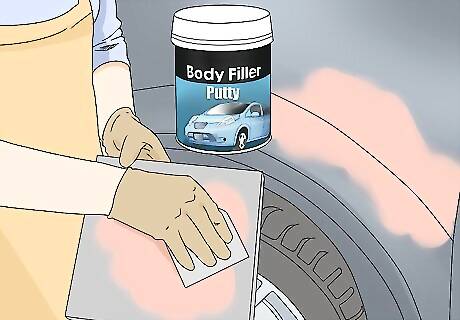
Fill in gouges, dings, and depressions with body filler putty. Mix your filler material to a cream consistency on a mixing board or piece of scrap cardboard. Then, spread it over any irregular areas in the body of the car using a clean spreader or buffing pad. It will help fill in these areas, resulting in a smooth, level painting surface. Make sure you use enough putty to fill in each damaged spot completely. To deal with smaller imperfections like pinholes, try a glazing putty. Glaze putties are thinner than ordinary fillers, which allows them to penetrate into places that thicker products can’t.

Wait for your filler material to harden. This will typically take 10-30 minutes, depending on the product you’re working with and the amount you’ve applied. In the meantime, avoid handling the putty. Otherwise, you may accidentally smudge an area you just repaired. Body filler materials don’t technically “dry,” they cure via chemical reaction. For this reason, a heat lamp or hair dryer can come in handy to help speed things along. Some body filler materials double as primers, which means you can paint right over them as soon as they’ve cured. Be sure to read the specifications on the product you’re using—it could end up saving you a lot of time.
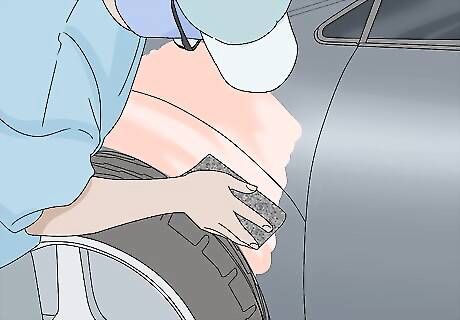
Sand the edges around the hardened filler to smooth it out. Once your putty has had time to cure completely, go over it with a sheet of sandpaper 150-180-grit sandpaper. Be sure to sand in all different directions, using vertical, lateral, and circular strokes to produce a seamless finish. While sanding your filler material, it’s especially important to feather the edges to minimize the chances of lines or ridges showing up in the finished paint. A block sander can make smoothing large areas easier and more comfortable.
Stripping the Existing Finish
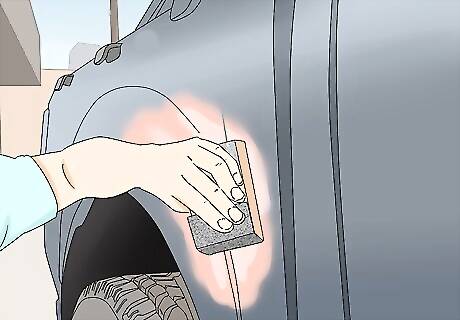
Go over your car with a sanding block to prepare it for minor touch-ups. If you only plan on freshening up your car’s paint in a couple spots, you can use a fine sanding block or Scotch-Brite pad to get it ready. Glide your sanding block in small circles over each section you want to paint to scuff up the outer surface. This will give it just enough texture to accept a fresh coat of paint. Make sure the block you’re using is no more than about 1,200-grit. Any smaller and it may not be able to rough up the existing paint properly.

Use an electric orbital sander to remove paint from large areas. Fit your orbital sander with a piece of 500-1,200-grit sandpaper or a sanding pad. A high-speed sander will allow you to work as quickly and efficiently as possible. In fact, it’s all but impossible to sand down to the base metal by hand, so having one is a must. If you don’t own an orbital sander, you may be able to rent one from your local hardware store or home improvement center for a small daily rate. Even with an electric sander, it may take hours to remove all the paint you need. This is one of the most time-consuming steps in preparing a car for paint, so be patient and don’t rush.Warning: Things can get pretty dusty while you’re sanding. Equip yourself with a pair of shop goggles and a respirator or dust mask to avoid breathing in harmful particles.
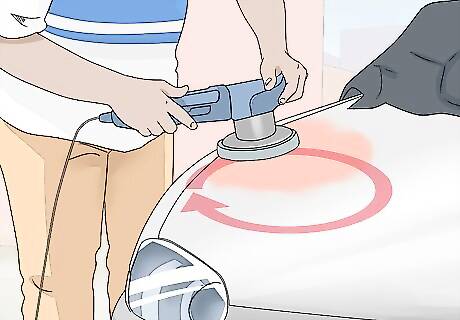
Run your sander in a circular motion over each area you’ll be painting. Apply consistent pressure to make sure you’re removing the same amount of paint from each part of the car’s exterior. You should see the existing paint fading a little more with each pass. Work your way over the entire painting surface in 1–2 ft (0.30–0.61 m) sections. If you’re going to be painting your car a different color, you’ll need to sand all the way down to the bare metal to prevent the old color from showing through.
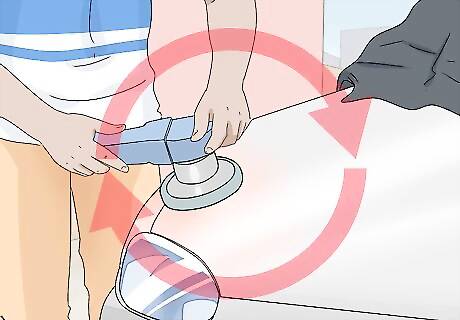
Continue sanding until there's no visible gloss or seams remaining. After sanding a given area, turn off your sander and give it a quick look. If you still see shiny patches or edged paint lines, it means you haven’t taken off enough of the old finish. Fire up your sander and go over the area again to ensure that your new paint will be able to take hold. It's important to make sure that the entire area has been scuffed evenly. Automotive paint and primer have a hard time sticking to smooth, glossy surfaces.

Wipe your painting area with a clean, wet rag to remove debris. Once you've finished stripping away the old finish, wet a lint-free shop cloth and run it over your vehicle's exterior to clear away the dust generated by sanding. Then, pat the surface dry with a clean microfiber cloth or chamois. If you proceed without cleaning your vehicle, you could end up with small particles trapped in the fresh paint.
Priming the Body for New Paint
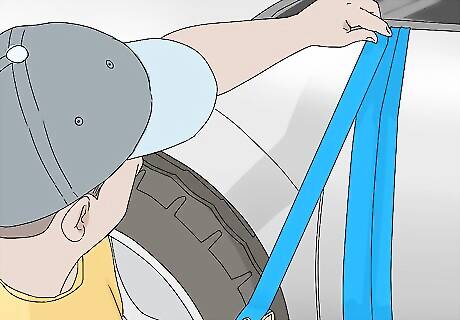
Mask any parts of the vehicle you don’t want to get primer on. Cover the areas surrounding your painting surface with newspaper or plastic sheeting and use strips of low-adhesive masking tape to secure the edges. Strategic taping will keep you from having to deal with messes as a result of drift and overspraying. If you’re painting one of the car’s back panels, for example, you’d want to make sure the rear wheel, trunk, and windows are all sealed off. It may also be a good idea to move your vehicle outside or park it on top of a dropcloth to prevent making a mess in your work area.Tip: If you’re only painting one small part and you have experience working on cars, consider removing the part so you can simply prime and paint it by itself.
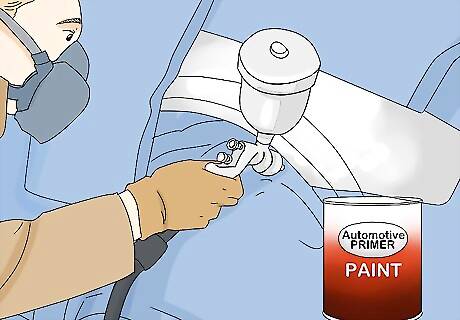
Apply a base coat of automotive primer using a paint sprayer. A sprayer will speed up the application process and help distribute the primer better. Hold the nozzle of the sprayer 6–8 inches (15–20 cm) away from the surface of the vehicle and pull the trigger to begin releasing the primer. Move the sprayer back and forth slowly over the area you’re painting, aiming for even coverage. Make sure your primer is properly thinned and mixed before you begin spraying. A standard epoxy or acid-etch primer will be the best choice for most projects. If you’re going to be painting over plastic, you’ll need to use a plastic-specific type primer instead. A thin base coat may be all you need if you’re just doing some touching up.
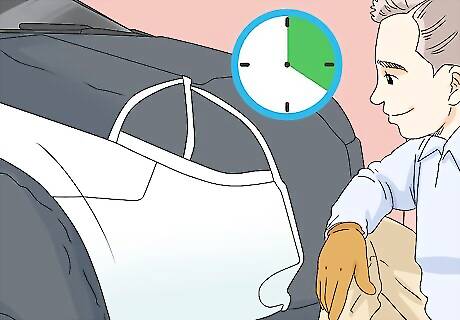
Wait 20-60 minutes for the initial coat of primer to dry. It’s important that your first coat have enough time to set completely before you move on to sanding and applying follow-up coats. Most automotive primers are formulated to dry in 30-45 minutes, and will be ready to sand in about an hour. Sanding primer while it’s still wet will just cause it to rub off, undoing all your hard work. Exact drying times will vary depending on the product used and how heavily you apply each coat.
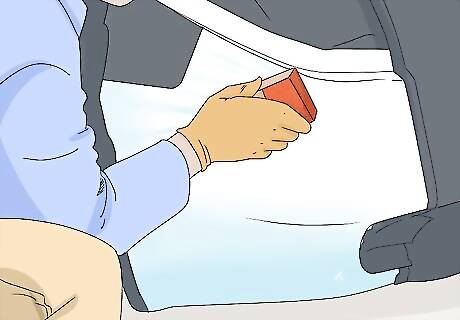
Block-sand the base coat to smooth out inconsistencies. If you happen to notice any rough or uneven spots in the dry primer, sand these out manually with a 1,200-grit fine sanding block. Use smooth, swirling motions and light pressure to wear down the area until it matches the surrounding surface. If you don’t find any glaring differences in texture, you can skip straight to applying your next coat of primer.
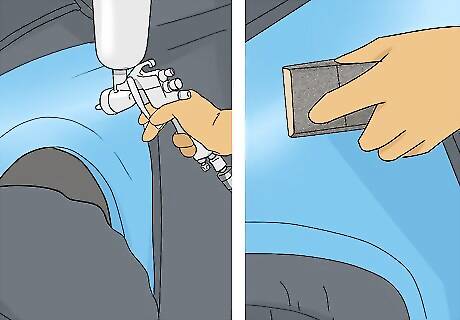
Prime and sand 1-2 more times to ensure a uniform finish. Be sure to allow each of your follow-up coats to dry for a full hour before sanding or starting the next coat. Once you’ve put on 2-3 even coats and factored in the recommended drying time, your vehicle will be ready for paint!




















Comments
0 comment